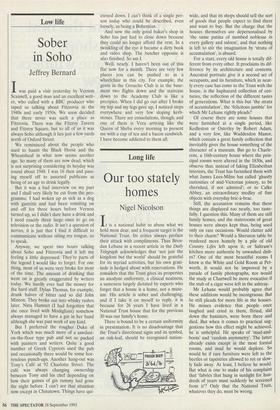Long life
Our too stately homes
Nigel Nicolson
It is a national habit to abuse what we hold most dear, and a frequent target is the National Trust. Its critics always preface their attack with compliments. Thus Bren- dan Lehane in a recent article in the Daily Telegraph acknowledges that 'not just the kingdom but the world' should be grateful for its myriad activities, but his own grati- tude is hedged about with reservations. He considers that the Trust gives its properties an anodyne uniformity, a clinical neatness, a sameness largely dictated by experts who forget that a house is a home, not a muse- um. His article is sober and challenging, and if I take it on myself to reply, it is because for 26 years I have lived in a National Trust house that for the previous 30 was our family's home.
There is bound to be a certain uniformity in presentation. It is no disadvantage that the Trust's directional signs and its symbol, an oak-leaf, should be recognised nation- wide, and that its shops should sell the sort of goods that people expect to find there and want to buy. But the charge that the houses themselves are depersonalised by `the same patina of numbed noblesse in every gallery and saloon', and that nothing is left to stir the imagination by 'strata of accumulation', is absurd.
For a start, every old house is totally dif- ferent from every other. It proclaims its dif- ference by its architecture and contents. Ancestral portraits give it a second set of occupants, and its furniture, which in near- ly every case has come to the Trust with the house, is the haphazard collection of cen- turies, the reflection of the different tastes of generations. What is this but 'the strata of accumulation', the 'felicitous jumble' for which Mr Lehane rightly pleads?
Of course there are some houses that were furnished at a single period, like Kedleston or Osterley by Robert Adam, and a very few, like Waddesdon Manor, which contain a great family collection that inevitably gives the house something of the character of a museum. But go to Charle- cote, a 16th-century house where the prin- cipal rooms were altered in the 1830s, and observe that, instead of faking Elizabethan interiors, the Trust has furnished them with what James Lees-Milne has called 'ghastly curiosities of mid-Victorian joinery, to be cherished, if not admired'; or to Calke Abbey, an extraordinary medley of fine objects with everyday bric-a-brac.
Still, the accusation remains that these things are displayed too neatly, too taste- fully. I question this. Many of them are still family homes, and the staterooms of great houses were always kept thus, being used only on rare occasions. Would clutter add to their charm? Would a Sheraton table be rendered more homely by a pile of old Country Lifes left upon it, or Saltram's kitchen more authentic by unwashed dish- es? One of the most beautiful rooms I know is the White and Gold Room at Pet- worth. It would not be improved by a parade of family photographs, nor would the study at Chartwell be more evocative if the stub of a cigar were left in the ashtray.
Mr Lehane would probably agree that these additions would be incongruous. But he still pleads for more life in the houses. He misses evidence that people once laughed and cried in them, flirted, slid down the banisters, were born there and died. But when it comes to practical sug- gestions how this effect might be achieved, he is unhelpful. He speaks of `mud-and- boots' and 'random asymmetry'. The latter already exists except in the most formal rooms, and mud he would deplore. So would he if rare furniture were left to the beetles or tapestries allowed to rot or slow- ly fade away. At least, I believe he would. But what is one to make of his complaint that 'fabrics that hung in sunlight for hun- dreds of years must suddenly be screened from it'? Only that the National Trust, whatever they do, must be wrong.


































































 Previous page
Previous page